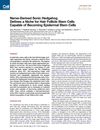TLDR Melanocyte stem cells are crucial for skin pigmentation and have potential in disease modeling and regenerative medicine.
The document reviewed the role of melanocyte stem cells (McSCs) in skin and hair pigmentation, highlighting their potential applications in regenerative medicine and disease modeling. McSCs, located in hair follicles, were crucial for hair pigmentation and could differentiate into melanocytes in response to stimuli like UV exposure. The study emphasized the importance of the MITF gene and various signaling pathways in melanocyte development. It also discussed McSCs' interactions with other cell types and their potential therapeutic targeting for skin disorders. Differences between mouse and human McSCs were noted, with unique human interfollicular populations suggested. The decline of McSCs was linked to hair greying, and their role in pigmentation disorders like vitiligo and potential link to melanoma was explored. The integration of pluripotent stem cell techniques with McSC research was seen as promising for understanding and treating melanocyte-related diseases.
 237 citations
,
June 2013 in “Nature Medicine”
237 citations
,
June 2013 in “Nature Medicine” A protein from certain immune cells is key for new hair growth after skin injury in mice.
51 citations
,
April 2013 in “Journal of Investigative Dermatology” Hair follicle stem cells rely on nearby blood vessels for their maintenance and function.
286 citations
,
June 2012 in “Nature Immunology” Hair follicles help attract immune cells to the skin during stress.
86 citations
,
February 2012 in “Journal of Clinical Investigation” Stem cells in hair follicles are diverse and change throughout the hair cycle.
 260 citations
,
June 2011 in “Cell”
260 citations
,
June 2011 in “Cell” Wnt signaling is crucial for pigmented hair regeneration by controlling stem cell activation and differentiation.
 396 citations
,
May 2011 in “Cell stem cell”
396 citations
,
May 2011 in “Cell stem cell” Nerve signals are crucial for hair follicle stem cells to become skin stem cells and help in wound healing.
 240 citations
,
April 2011 in “Pigment Cell & Melanoma Research”
240 citations
,
April 2011 in “Pigment Cell & Melanoma Research” Melanocyte stem cells in hair follicles are key for hair color and could help treat greying and pigment disorders.
283 citations
,
February 2011 in “Cell stem cell” COL17A1 is crucial for preventing hair graying and loss by supporting hair and pigment stem cells.
164 citations
,
February 2010 in “Journal of Cell Science” Human dermal stem cells can become functional skin pigment cells.
 April 2023 in “Journal of Investigative Dermatology”
April 2023 in “Journal of Investigative Dermatology” Blocking casein kinase 1 in skin cells can help melanocyte precursors move better, potentially helping with conditions like vitiligo or gray hair.
 240 citations
,
April 2011 in “Pigment Cell & Melanoma Research”
240 citations
,
April 2011 in “Pigment Cell & Melanoma Research” Melanocyte stem cells in hair follicles are key for hair color and could help treat greying and pigment disorders.
 10 citations
,
November 2010 in “Pigment Cell & Melanoma Research”
10 citations
,
November 2010 in “Pigment Cell & Melanoma Research” Only skin melanocytes, not other types, can color hair in mice.
 75 citations
,
January 2009 in “International journal of trichology”
75 citations
,
January 2009 in “International journal of trichology” Hair grays due to oxidative stress and fewer functioning melanocytes.






